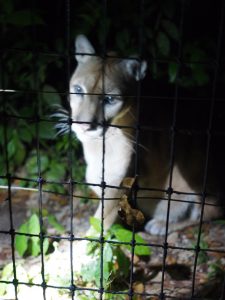There we were, with flashlights in hand, meandering through the darkness of the Belize Zoo. The site was sprawling with tall tropical trees, including the Santa Maria tree (Calophyllum brasiliense) and the gumbo-limbo (Bursera simaruba), spectacular sights on their own. The Santa Maria trees, not very common and interspersed between shorter trees, had branches high up on the trunk and were some of the tallest trees at the zoo. The gumbo-limbo trees were also fairly uncommon and were shorter with bark that was peeling in fleshy-looking pinkish layers. I was unable to see any animal activity in the trees because we visited the zoo at night.
The trees were unscathed by the human activity necessary for the zoo’s survival; enclosures were constructed around established trees to preserve the integrity of the site. All of the zoo’s animals are native to Belize, and the zookeeper addressed each and every animal by name – Carlos the puma, Junior the jaguar, Maggie the frigatebird, Brutus the American crocodile.

One could feel the zoo’s authenticity. The zoo lacked kitsch. It lacked glamour. It was about people learning about the animals of Belize.
Earlier in the day, my class departed from Glover’s Reef, our home for the past week. Partway through our boat ride to the Belize mainland, we hiked and snorkeled through the Belize mangroves. At a glance, the area would not have looked appealing, with its sediment-filled water, knotted overgrown tree roots, and an absence of colors other than browns and corrupted greens.
However, the mangrove housed a wide variety of creatures. Today’s sightings covered the whole spectrum –red cushion sea stars (Oreaster reticulatus) to sun anemones (Stichodactyla helianthus) to a seahorse (Family Syngnathidae). The red cushion sea stars were amotile and were about six-inches in diameter. The most memorable sighting was a manatee (Genus Trichechus). Although I got little more than a glimpse of shimmery gray with chestnut speckles, it felt a sense an overwhelming sense of awe being in the present of a creature as majestic as a manatee.
Ecologically, mangroves are essential to the survival of many types of animals, including coral-residing species, as the shallow waters and networks of plant materials protect growing animals from predators. Despite not being the most popular image to send home on a postcard, mangroves are a necessity for the survival of countless living things.
That is authenticity.

